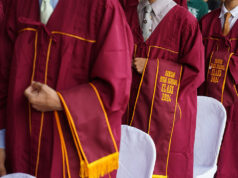Bringing a tradition back
THE 1970s were a dark time for the Philippines, mostly due to the atrocities of the Marcos regime. For better or for worse, there were some bright spots in the arts during that period, mostly due to the spendthrift former First Lady, Imelda Marcos. Fashion-obsessed Mrs. Marcos nurtured fashion designers and wore their clothes on the world stage, lending her very visible visage to Filipino designers. Galas for this and that ran every evening, and in 1979, Filipino designer Ben Farrales, known as The Dean of Philippine Fashion, organized a Flores de Mayo parade at the Manila Hotel, under the Congregacíon del Santissimo Nombre del Niño Jesus. Beauty queens and celebrities participated in the parade that honored the Virgin Mary, part of the Catholic devotions to Mary during May.
The Manila Hotel tradition eventually ended after a run of about 20 years.
This year, the Manila Hotel revived the tradition with its own Flores de Mayo, staged on Labor Day. This time, the parade was populated with models and pageant personalites. The clothes were furnished by members of the Designers Circle of the Philippines, with an underlying theme of 19th-century traje de mestiza, otherwise known as the Maria Clara.
The traje de mestiza is an east-meets-west amalgamation of the influences that shaped colonial Filipino society. The base of the dress is the traditional baro’t saya (blouse and skirt) and a continuing evolution since the 1700s can be seen in the gown’s components: the panuelo (fichu), for example, is a relic from the 1700s, while the wide sleeves are a bequest from the Victorian Era of the 1800s.
In any case, the 30 pairs of attractive people dressed in their Filipiniana best went down the same route as in the 1979 parade, going along the hotel’s facade and circling back for a dinner at the Maynila Ballroom, but not before offering flowers at a statue of the Virgin Mary. It was a spectacular show, with these bejeweled young ladies in their fussy ternos, making the wearing of the heavy garments a worthy sacrifice for a good spectacle.
Awards for Magandang Paraluman (Beautiful Muse) and Natatanging Ginoo (Oustanding Gentleman) were given to Sheena Dalo (Ms. Philippines Earth 2016) and Aaron de Tommaso. The Bestido Pilipino Award was given to Santa Emmanuelle for a sequinned black number with feathers on the skirt, topped with a veil. The Bituin ng Gabi (Star of the Night) award was given to designer Edwin Uy and his model, Samantha Lo, for a lovely pink traje de mestiza, both opulent and innocent, topped with a pink veil, golden tassels, and a gold-embroidered train.
Manila Hotel President Joey Lina said, “The present management deems this [as] a very good tradition to revive.”
“Manila Hotel symbolizes what is truly Filipino.” — Joseph L. Garcia



